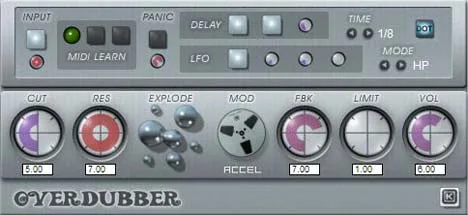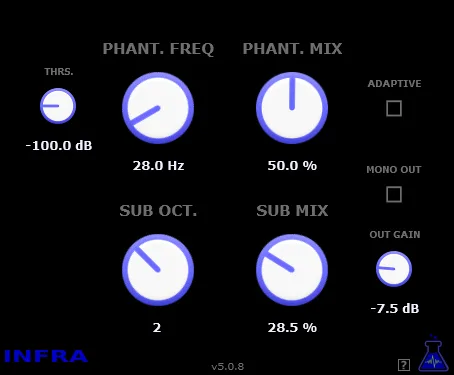Delving into the Depths of Dub: A Detailed Review of Klanglabs’ OverDubber Plugin
Greetings, esteemed audio engineers, musicians, and anyone in love with the magic of sound! Today, we’ll dive into the world of resonating repeats and atmospheric spaces with the OverDubber plugin, developed by the Klanglabs team. This VST effect is specifically designed for those seeking authentic dub sound while also having flexible tools for dynamic delay control, especially during live performances or creating tracks that demand immediate reaction and creative sound manipulation. OverDubber goes beyond standard delay plugins, offering a unique set of features that make it a powerful tool in your creative arsenal. Its intuitive interface and specialized capabilities make the process of creating complex dub effects as simple and exciting as ever. If you’re looking for a plugin that combines classic dub vibes with modern control options, OverDubber deserves your closest attention.
Advanced Functionality and Features
- Two Tap Delay Architecture: OverDubber is built around the concept of a two-tap delay. This means you have two independent “echoes” that can be adjusted separately in time, feedback level, and panning. This configuration is fundamental for creating characteristic dub rhythms, polyrhythmic delays, and a sense of spatial depth. The ability to flexibly control each tap opens up endless possibilities for sound experimentation.
- Precise Tempo Synchronization (BPM Sync) and Quick Access to Dotted Time: Integration with your project’s tempo (BPM) ensures that your delays will always be “in step” with the music. This is critically important for maintaining groove and rhythmic integrity. An additional dotted time button allows you to instantly switch the delay time to the corresponding dotted values (e.g., 1/8D, 1/4D), which is extremely convenient for quickly creating dub and reggae rhythmic patterns.
- Innovative “Explode” Trigger: This feature is one of OverDubber’s hallmarks. Activating “Explode” instantly creates a controlled burst of feedback that can quickly fade or be used to create long, resonating loops. It’s the perfect tool for dramatic transitions, accentuating certain parts of a mix, or creating epic swells during a live performance. Full control over this parameter allows you to avoid unpredictable and unwanted effects.
- Full MIDI Learn Support for Maximum Control: For musicians who perform live or producers who actively use automation, the MIDI Learn function is simply indispensable. You can easily assign any plugin control or button to your physical MIDI controller, allowing you to manipulate delay parameters in real-time with high precision and expression. This opens up new possibilities for interactive sound creation.
- The Life-Saving “Panic!” Button: While experiments with feedback can be incredibly creative, sometimes the situation gets out of control, leading to a sudden increase in volume or unwanted feedback. The “Panic!” button instantly resets all feedback loops and clears the delay buffer, allowing you to quickly return to a safe volume level and continue working without interruption. This is especially important during live performances.
- Pitch-Modulation (Pitch-Mod) Mimicking Tape: To give your delays a vintage character and analog warmth, OverDubber includes a Pitch-Mod function. It emulates the subtle fluctuations in the speed of magnetic tape, which gives the sound an organic feel and slight detuning. This adds a sense of “liveness” to your effects.
- “Tape Reel Knob” for Manual Speed Control: This is another unique feature that refers to working with classic tape echo machines. Rotating this virtual control, you can manually change the delay speed, resulting in characteristic pitch-shifting effects during repeats. It’s a powerful tool for creating unique transitions, scratch-like sounds, or simply adding expression to your mix.
- Two “Tape Reel” Operating Modes: “Accel” and “Scratch”: To expand the possibilities of manual control, the developers have provided two operating modes for the “Tape Reel” control. The “Accel” (Acceleration) mode simulates a smooth acceleration or deceleration of the tape, leading to corresponding pitch changes. The “Scratch” mode presumably simulates more abrupt and intermittent movements, similar to scratching, creating more extreme and rhythmic effects on the repeats. *To fully understand the nuances of these modes, experimentation is recommended.*
In conclusion, OverDubber from Klanglabs is not just a delay plugin, but a real creative tool for creating atmospheric soundscapes, dynamic effects, and, of course, authentic dub sound. Its specialized functions, focused on live performances and deep sound experimentation, make it a valuable asset for any producer’s or musician’s studio. Available in VST format for the Windows operating system (Win32), OverDubber is ready to add depth and uniqueness to your mixes. Try it today and let your sounds resonate in a new way!



